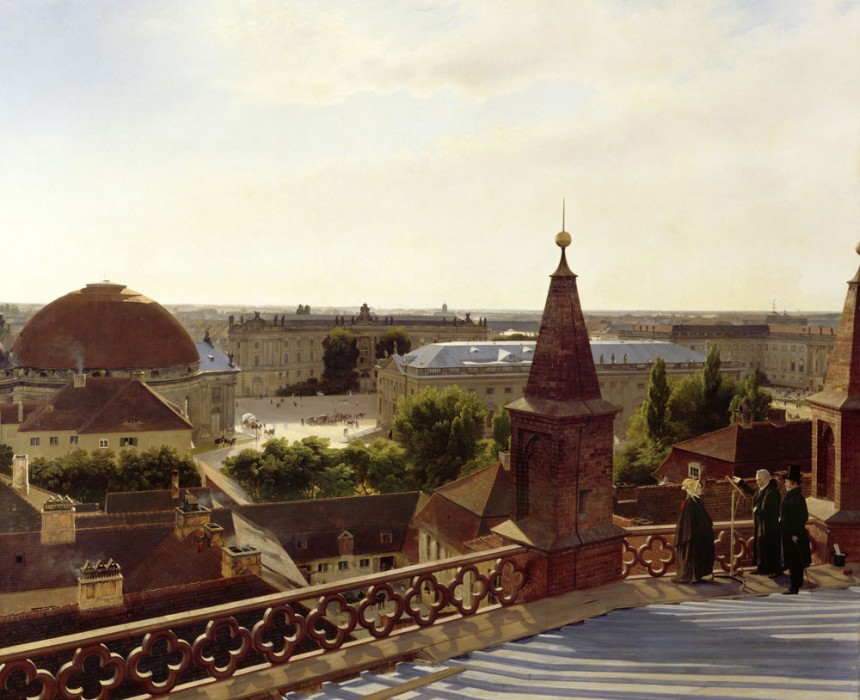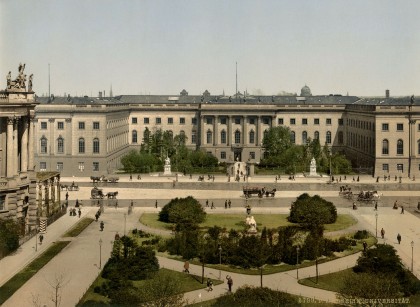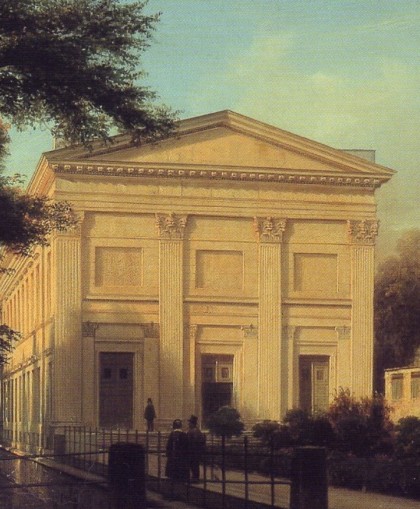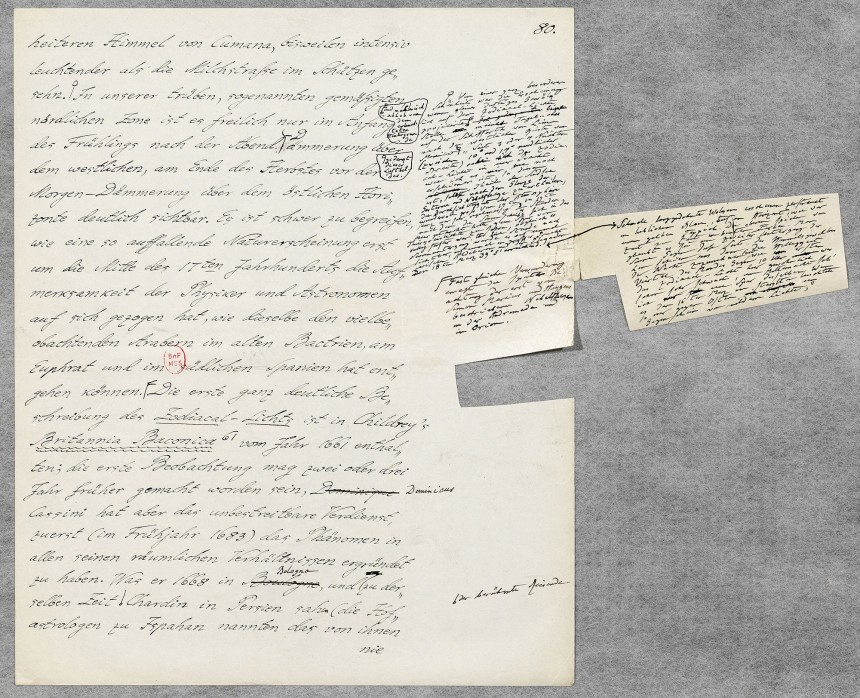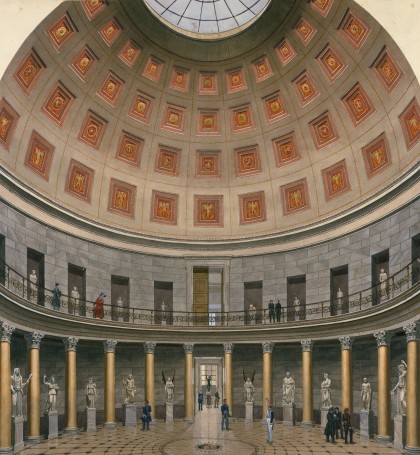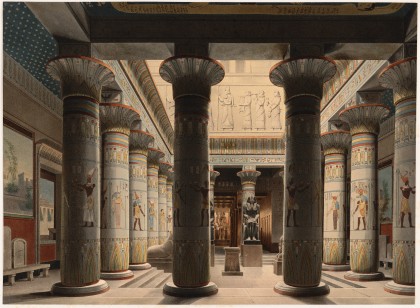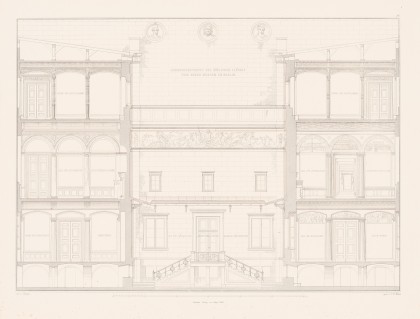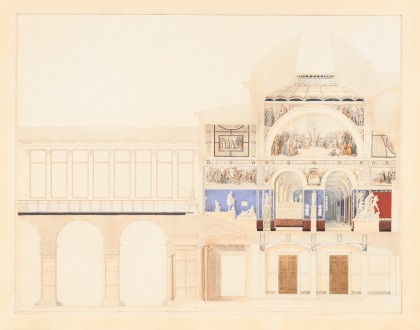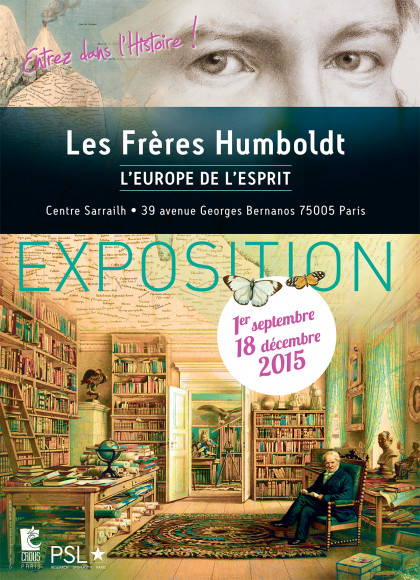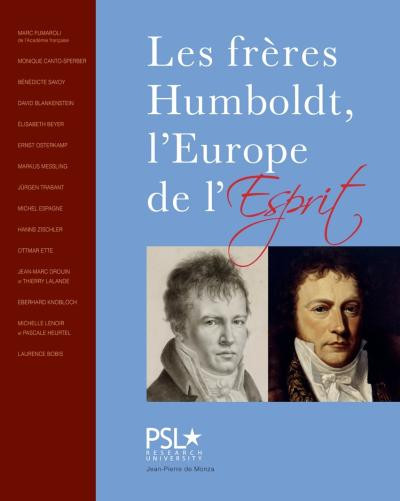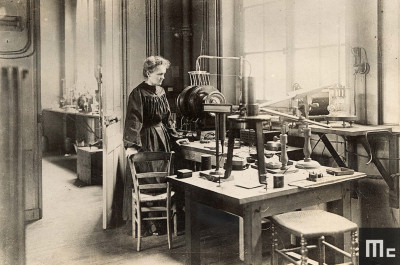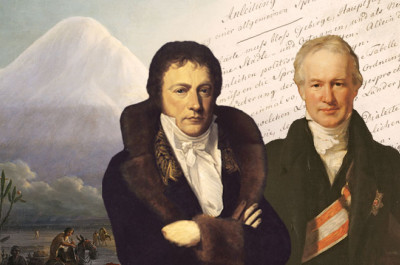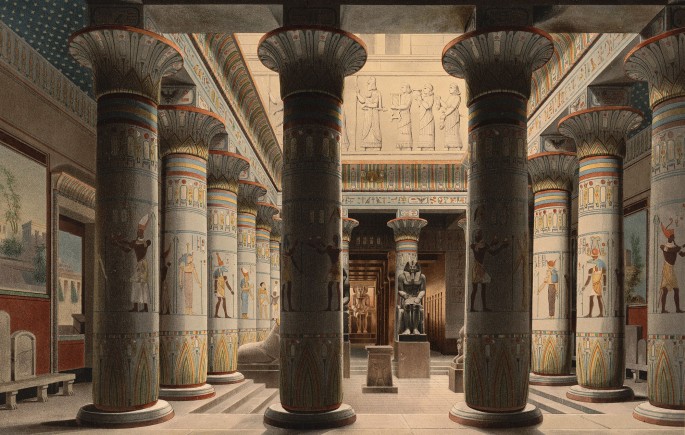
Fundament and legacy
Academic reforms
Nineteenth century European cultural history is marked by the emergence of new centers for cultural exchange and innovation. Within a few decades, under the driving influence of the Humboldt brothers, Berlin acquired an internationally renowned university and two public museums.
University of Berlin
Beginning in 1807, Friedrich Wilhelm III launched a program of radical reform designed to modernize Prussia. Appointed Director of Ecclesiastical Affaires and Education at the Prussian Ministry of the Interior on February 28th 1809, Wilhelm was responsible for radically reforming the Prussian educational system.
Humboldt's based his approach to educational reform on Plato's writings, his own theories on the State as well as the ideas of fellow educational reformers such as the Swiss pedagogue and educational reformer Johann Heinrich Pestalozzi.
He drew up plans for a free and universal system of general education (Allgemeine Bildung) for all citizens. The system was divided into three stages: Elementary (providing Basic Education or Fundament), Secondary and University.
Curriculum at the newly created secondary schools, or Gymnasien, was organized around the study of classical languages (ancient Greek and Latin) with an emphasis on the Humanities. Henceforth, the role of secondary schools was to prepare pupils for University studies.When it opened its doors in 1810, the University of Berlin, founded by Humboldt, was the most modern university of its day.
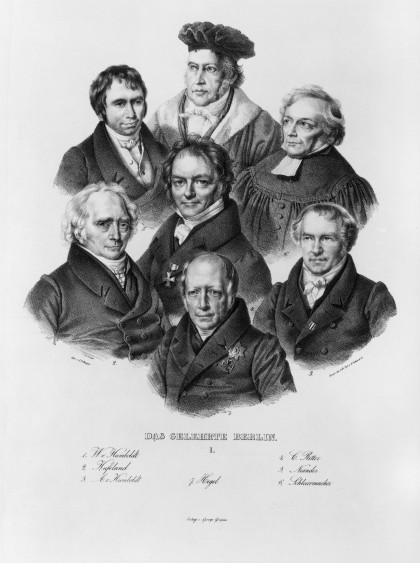
Julius Schoppe, circa 1810, 49,2 x 32,7 cm, Berlin, Staatliche Museen, Kupferstichkabinett, © BPK, Berlin / Dist. RMN-Grand Palais / Jörg P. Anders
In keeping with his deeply liberal beliefs, Wilhelm von Humboldt created a university model based on the principals of freedom in the elaboration of scientific knowledge (research) and the autonomy of instruction, where teaching and research came together in a single institution. In contrast to other universities, often reduced to dispensing what one could qualify as occupational training, Humboldt's university was to be an institution of general education whose mission was to train free-spirited minds and to promote pure, disinterested research.
The University of Berlin, run by a largely autonomous administration, engaged an impressive list of faculty including Friedrich Schleiermacher and Johann Gottlieb Fichte (who influenced Humboldt's concept of university) as well as August Böckh, Albrecht Daniel Thaer and Carl Ritter.
The University of Berlin, renamed Humboldt University in 1949, rapidly became one of Germany's foremost universities. Humboldt's model has withstood the test of time and has significantly influenced university education across the globe.
The Cosmos
It is only in 1827 at 57 years of age, that Alexander von Humboldt returned to settle in his native Berlin. With the University of Berlin, founded in 1809 on his brother Wilhelm's initiative, the Prussian capital had become a center for serious, forward-looking scientific research. Alexander, with his strong Europe-wide scholarly and scientific network and his international reputation, contributed significantly to developing Berlin's intellectual life.
In 1828, Alexander presided over the Berlin meeting of the Versammlung Deutscher Naturforscher und Ärzte, an recently founded association of naturalists and physicians, attended by 458 German and European scholars.
But it was his Cosmos lectures that marked a generation of German intellectuals and artists. Cosmos began as a lecture series on Science and Nature at the University of Berlin in the winter of 1827-28. It turned into a 25-year-long endeavor culminating in a 5-volume treatise published between 1845 and 1862.
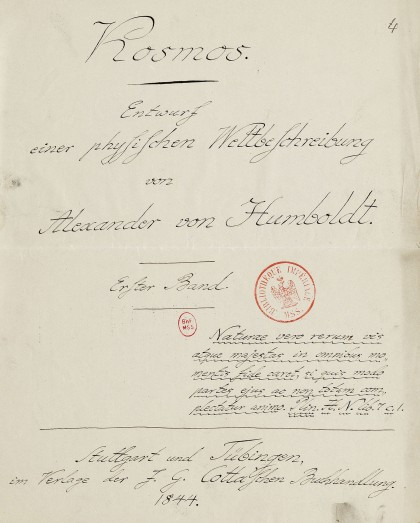
Alexander von Humboldt, Eduard Buschman (scribe), 1844, Bibliothèque nationale de France, Département des manuscrits, Allemand 232, © Bibliothèque nationale de France
Alexander von Humboldt began writing his "Sketch of a Physical Description of the Universe", an essay on contemplating and understanding the physical world, around 1820 while living in Paris. But it was only in 1845, when he was close to 80, that he finally published the first volume of Cosmos.
Cosmos is a monumental compendium of empirical knowledge of the physical universe in which Alexander uses both his own observations and the most recent scientific advances of his fellow scholars around the world. It is not an encyclopedia but rather a treatise through which Alexander brings the different fields of scientific knowledge of his time together in one encompassing system to demonstrate both the "unity of Science" and the "unity of Nature". The treatise begins by painting a portrait of Nature from the 'cosmos' to the earth and continues with a history of Science and Art, an intellectual history of man's perception of Nature; and concludes with detailed accounts of scientific studies in all of the physical sciences.
The fifth volume of Cosmos was published following Alexander's death. Despite the skepticism of some contemporaries, who believed it vain to attempt assembling all knowledge in a single treatise, the work was a huge success in Germany, where the first edition of Volume I sold out in a mere 8 weeks. By 1851, an estimated 80,000 copies had been printed and shipped. Translated into French, English, Dutch, Italian and Spanish by 1846, the book became an international phenomenon, a perfect example of the newfound importance of Science to 19th century society.
The Altes and the Neues Museums
Public Museums
In contrast to other German-speaking capitals such as Vienna, Munich, Dresden, Düsseldorf and Kassel, there were no public museums in late 18th century Berlin. So Wilhelm and Alexander Humboldt were introduced to the concept and very existence of these institutions as young men travelling through Europe. Each was able to appreciate the museums, their charm and sanctity, merit and purpose from his own intellectual perspective.
Wilhelm and the Altes Museum
Wilhelm von Humboldt was closely involved in creating Berlin's first public museum. In 1829, the King of Prussia appointed him head of the Museum Selection Committee, in charge of choosing the works to be presented and determining how they were to be exhibited. Working with the Architect Karl Schinkel, Wilhelm designed the Altes Museum, Prussia's first public museum.
The Altes Museum was intended for the students of the Academy of Painting, art history students of Berlin University and more broadly to serve the entire Berlin community. It embodied the concept of Bildung, self-cultivation through art. When it opened its doors on August 30th 1830, the museum presented primarily classical Greek and Roman sculpture and masterpieces of the great Italian, Dutch and German Masters.
Though a latecomer to the European museum world, the Altes Museum was to play a central role in making Berlin a European cultural center.
Alexander and the Neues Museum
While Wilhelm von Humboldt was behind the creation of Berlin's first public museum, Alexander was instrumental in founding Berlin's second museum, the Neues Museum. Built as an extension to the Altes Museum, to which it was connected by a suspended walkway, the building was to house collections focusing on world culture.
The Neues Museum housed the King of Prussia's Egyptian collections, ethnographic objects, classical monuments uncovered during regional digs, a collection of castings of classical artifacts and the prints and drawings collection. It was an ambitious, universal project conceived to give the institution a seat in the concert of European museums.
Related events and resources
Exhibition at the CROUS de Paris
In 2014, Paris Sciences et Lettres produced its first exhibition, in close collaboration with researchers and prestigious institutions in France and in Germany. One year later, PSL and the CROUS de Paris joined forces to bring the exhibit to the heart of our academic community. At the Centre Sarrailh, students, faculty and staff could visit and revisit the exhibit, discover and draw inspiration from Alexander and Wilhelm von Humboldt and their extraordinary lives of travel, scientific discovery, innovation and accomplishment.
Dates: September 1st through December 18th 2015 Entry: Free of charge
Opening hours: Open to the public Monday tnrough Friday from 9:30 am to 4::30 pm.
Place: Centre Sarraih, 39 avenue Georges Bernanos, 75005 Paris
Catalogue of the exhibition
Les frères Humboldt. L'Europe de l'esprit, publisher: De Monza, 2014, 200 pages.
This catalogue accompanies the exhibition "Les frères Humboldt, L'Europe de l'Esprit" (The Humboldt brothers – The Spirit of Europe) produced by Paris Sciences & Lettres (PSL) and shown at the Observatoire de Paris from May 15th through June 30th 2014. The catalogue is divided into 5 sections, mirroring the exhibition's main themes: "Matrix: family background and contemporary interest in classical Antiquity", "Res Publica: Revolution. Regeneration", "Europe and the World: Otherness as an intellectual horizon", "Morphologies: of parts and the whole", and "Sharing knowledge". The catalogue is far more than a simple visual reminder of the exhibition (maps, objects, letters and publications), it is also a theoretical work comprising 10 essays written by eminent scholars.
Throughout the catalogue, insets by Laurence Bobis, Director of the Observatoire de Paris library, provide the reader with additional bibliographic, political and scientific information. The catalogue is designed for the general public, for visitors to the exhibition and for informed or academic readers. Its intention is to prolong the exhibition experience and emphasize the intellectual, philosophical and ethical values to which the Humboldt brothers devoted their lives. These brilliant polymath intellectuals, one focused on science, the other on the humanities, were driven by a deep and unwavering humanism and a shared vision for a unified Europe, founded on progress and knowledge.
The catalogue can be found on most on-line book platforms as well as at the l'Ecume des pages bookshop (174 Boulevard Saint-Germain, 75006 Paris).
About the exhibition
This virtual exhibition follows on the physical exhibition The Humboldt brothers – The Spirit of Europe held at the Observatoire de Paris from May 15th through July 11th 2014. A smaller physical version of the exhibition was shown in 2015 at the Centre Sarrailh, 39 avenue Georges Bernanos, thanks to a PSL /CROUS de Paris partnership.
The Humboldt brothers have become a symbol of the intellectual, philosophical and ethical values that bind France and the Germanic World despite their tumultuous political history: a fascination for classical Antiquity and a deep attachment to rationalism and universalism. The exhibition is a first for PSL - Paris Sciences et Lettres Research University, and the first French exhibition devoted solely to the Humboldt brothers. Our goal: to open a window onto the extraordinary intellectual effervescence of a era when anything was possible, by presentation the life and work of two stellar intellectuals, their insatiable curiosity for the world around them, their commitment to advancing and sharing knowledge and science, and their incredible talent for innovation.
The Humboldt brothers influenced generations of intellectuals and scholars the world over. PSL shares their fundamental belief in the unity of the Sciences and the Arts and the academic ideals they defended: a university founded on the principles of scientific excellence, where academics and research are intimately linked, and where all disciplines coexist without boundaries, from astrophysics to the visual and performing arts, from mathematics to the humanities.
Click here to download the press kit [1502.0Ko]
Physical exhibition curated by
Bénédicte Savoy, Professor of Art history, Berlin
David Blankenstein, graduate in art history and museum studies
Produced by
Paris Sciences et Lettres Research University (PSL), in partnership with Labex TransferS.
Scientific Committee
Under the chairmanship of Marc Fumaroli, member of the Académie française.
- Elisabeth Beyer - cultural attaché in charge of books at the French Embassy in Germany
- Laurence Bobis - Director of the Observatoire de Paris library
- Monique Canto-Sperber - (then) President, Paris Sciences et Lettres Research University
- Barbara Cassin - Director of Research, CNRS
- Michel Espagne - Director, Labex TransferS
- Ottmar Ette, Professor - University of Potsdam
- Christine von Heinz – owner of Tegel Castle and the castle archives
- Ulrich von Heinz - owner of Tegel Castle and the castle archives
- Eberhard Knobloch – Professor Emeritus, Technische Universität Berlin (Technical University of Berlin)
- Michelle Lenoir, Director of the Muséum national d'histoire naturelle main library
- Central library - Henri Loyrette, Conseiller d'Etat, France
- Daniel Marchesseau, conservateur général honoraire du patrimoine (honorary Conservator General of Culture)
- Hermann Parzinger, President of the Stiftung Preußischer Kulturbesitz (Prussian cultural Foundation)
- Jürgen Trabant, Professor Emeritus, Die Freie Universität Berlin (Free University Of Berlin)
Acknowlegements
Marc Fumaroli and Monique Canto-Sperber would like to thank:
The Honorables Susanne Wasum-Rainer, German Ambassador to France
Mr. Louis Gallois and Mr. Louis Schweitzer, Commissaires généraux à l'investissement (Frenchgovernment investment comissioners)
Mr. Claude Catala, President, the Observatoire de Paris
The founding members of the Paris-Sciences et Lettres Foundation, members of Labex TransferS and and its Director Michel Espagne
La République des Savoirs and its director Antoine Compagnon
As well as:
Emmanuel Suard and Hubert Guicharrousse (Berlin, French Embassy in GermanyAllemagne), Hinrich Sieveking (Munich, Winterstein collection ), Heinrich Schulze Altcappenberg (Berlin, Kupferstichkabinett SMB-PK), Isabelle le Masne de Chermont (Paris, BNF), Caroline Noyes and Gabriel Carlier (Paris, MNHN), Manfred Gräfe and Cornelia Gentzen (Berlin, Stiftung Stadtmuseum, Humboldt-Sammlung Hein and Hausarchiv), Hans-Dieter Nägelke and Claudia Zachariae (Berlin, Technische Universität, Architekturmuseum), Stéphanie Baumewerd, Annick Trellu and Philippa Sissis (Berlin, Technische Universität, Art History Institute), Elisabeth Michel (Berlin), Sandrine Maufroy (Paris, Université Paris 4-Sorbonne), Emilie Oléron Evans (London, Queen Mary, University of London), Marie-Ange Maillet (Paris, Université Paris 8-Saint-Denis), Vincent Platini (Berlin, Freie Universität), Leah Stearns (Monticello, Thomas Jefferson Foundation at Monticello).
Project coordinators
Hélène Chaudoreille
Véronique Prouvost
Virtual exhibition production
Nathalie Figueroa
Assisted by
Annael Le Poullennec and the team at the PSL Resource and Knowledge department
Dimitri Le Meur, ENS.
Translation
Robin Silver-Delouvrier (French to English)
Voice recordings (readings)
Thomas Claret, Alice Billon, Anne Buers
Image credits
- Gottlieb Schick, Wilhelm von Humboldt, 1808, oil on canvas, 86 x 66 cm, © Berlin, Deutsches Historisches Museum
- Henry William Pickersgill, Alexander von Humboldt, 1831, oil on canvas, 142,2 x 109,2 cm © Bridgeman Art Library
- Johan Weitsch, Humboldt et Bonpland au pied du Chimborazo en Equateur (Humboldt and Bonpland at the foot of mount Chimborozo...), 1806, oil on canvas, 163 x 226 cm © BPK, Berlin, Dist. RMN-Grand Palais / Hermann Buresch
- Wilhelm von Humboldt, Anleitung zur Entwerfung einer allgemeinen Sprachkarte [Instructions for making a general map of spoken languages], annex to a letter from Wilhelm von Humboldt to Goethe dated November 15th 1812, ink on paper, © Weimar, Klassik Stiftung Weimar, Goethe und Schiller-Archiv

